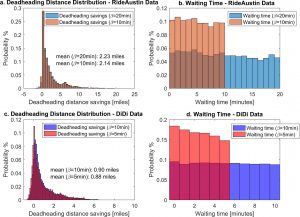
Our paper on reducing ridesourcing empty vehicle travel with future travel demand prediction appeared at the Transportation Research Part C: Emerging Technologies journal. This paper was motivated by the potential to reduce deadhead mileage of ridesourcing trips by providing drivers with information on future ridesourcing trip demand. Future demand information enables the driver to wait in place for the next rider’s request without cruising around and contributing to congestion. A machine learning model was employed to predict hourly and 10-minute future interval travel demand for ridesourcing at a given location. Using future demand information, we developed algorithms to (i) assign drivers to act on received demand information by waiting in place for the next rider, and (ii) match these drivers with riders to minimize deadheading distance. Real-world data from ridesourcing providers in Austin, TX (RideAustin) and Chengdu, China (DiDi Chuxing) were leveraged. Results show that this process achieves 68%–82% and 53%–60% reduction of trip-level deadheading miles for the RideAustin and DiDi Chuxing sample operations respectively, under the assumption of unconstrained availability of short-term parking. It was a great opportunity to collaborate with colleagues from the Center for Integrated Mobility Sciences of the National Renewable Energy Laboratory! More info here.
